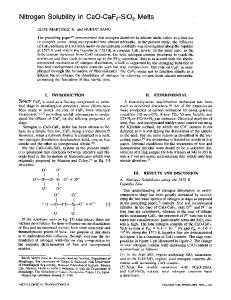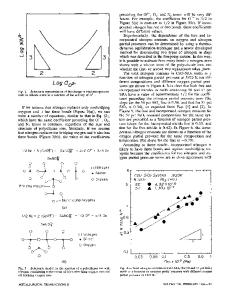Solubility and thermodynamic properties of Li 2 O in LiF-CaF 2 melts
- PDF / 433,698 Bytes
- 5 Pages / 603.28 x 783.28 pts Page_size
- 88 Downloads / 340 Views
I.
INTRODUCTION
T H E R E is an ever-growing demand for the use of A1-Li alloys in the aerospace industry, because of their lightweight and improved modulus. The increase in demand was due to rapid escalation of fuel costs, higher thrust for more fuel efficient aircraft, and improved overall structural properties of A1-Li alloys over the existing aerospace structural aluminum alloys. Reduction in aircraft weight is one means of decreasing fuel consumption. Since the majority of aircraft frames are made out of aluminum alloys, development of low-density structural aluminum alloys is of paramount interest. Each weight percent lithium added to an alloy reduces the density 3 pct and increases the elastic modulus by 6 pct. t~ Addition of lithium to aluminum also improves the corrosion resistance. Ie~ The use of A1-Li alloy airframe structures in civil and military aircraft are projected to increase from 15 pct in 1990 to 33 pct by 1995.tl1 The present commercial method for production of A1-Li alloys is by the melting and casting method involving the use of pure metallic lithium which is added to the molten aluminum.t3.4~ The production of A1-Li alloys by mixing the pure metal is an energy intensive and expensive process. Considering the relatively high prices for high-purity lithium metal, a new process is investigated in the present research to prepare lithium by in situ electrolysis of lithium oxide to A1-Li alloys in fluoride electrolytes. The principal objective of the described research is to develop physicochemical information that can be applied to the direct production of A1-Li alloys by electrochemical method. To study the viability of a process for obtaining a metal from its oxide, it is necessary to obtain sufficient information on the solubility of the oxide in fluoride melts. While extensive studies have been done for the AlzO3-cryolite system, ~5-8lvery little work has been done for other oxide-halide systems. Belyayaev 19~ found that mixed fluorides, particularly cryolite (Na3A1Fr), are good solvents for metal oxides, while Stern tl~ found that
R.G. REDDY, Professor and Chairman, and S.G. KUMAR, Graduate Student, are with the Department of Chemical and Metallurgical Engineering, University of Nevada-Reno, Reno, NV 89557. Manuscript submitted February 22, 1993. METALLURGICAL TRANSACTIONS B
molten chlorides have a very limited solubility for metal oxides. Haupin tllj studied the solubility of A1203 in A1C13-LiC1 melts and predicted a simple model for the reaction between the oxide and chloride to form the dissolved species. He predicted the dissolved species to be A1OC1 and found that the A1203 solubility increases with the cube root of activity of A1C13. Wai and Blander tl2~ studied the solubility of A1203 in eutectic LiC1-KC1 containing dissolved A1C13 using a proton activation technique. The presence of A10 + complex species in the melt was identified and a formation constant for the A10 § was deduced. From the solubility data, they obtained a value of 300 kJ/mole for the specific bond Gibbs energy f
Data Loading...











